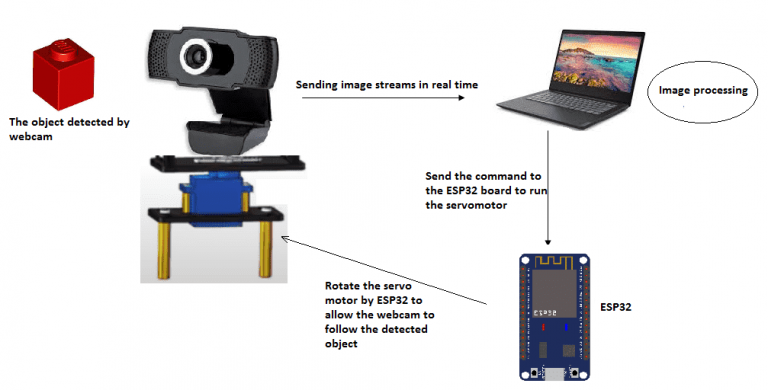

- #ARDUINO CAMERA RECOGNITION HOW TO#
- #ARDUINO CAMERA RECOGNITION INSTALL#
- #ARDUINO CAMERA RECOGNITION SERIAL#
- #ARDUINO CAMERA RECOGNITION SOFTWARE#
To check if this is the case, click on the following link: If your router supports mDNS (most do), you won't need the IP address and will be able to use an easier (non changing) hostname.
#ARDUINO CAMERA RECOGNITION SERIAL#
Open the Serial Monitor to take note of the IP address of the Esp32 camera. Serial.println(feed.getWelcomeMessage()) While (!cam.connect(WIFI_SSID, WIFI_PASS)) You can change it to whatever you want, 80 is the default for HTTPĮloquent::Esp32cam::Http::LiveFeed feed(cam, 80) Once loaded, the Esp32-cam will connect to your WiFi network and start an HTTP video streaming server you can access from any web broswer. It is reported here for faster copy-paste. Once your setup is ready, load the 4_Video_Feed.ino example sketch from the EloquentEsp32Cam library examples. Image classification often happens at even lower resolutions anyway, so if you're not using the large version of the image for other purposes, QQVGA is the best choice Image classification on Esp32-cam can be implemented in 30 minutes, with minimal code configuration, thanks to the Eloquent Arduino ecosystem of libraries: once deployed, it takes 1 kb of RAM and runs at 60 FPS.įollow the next steps to get up and running! Since your cheap Esp32-cam usually comes with limited RAM, you will often be forced to opt for a low complexity, low accuracy network.Įven more, with weight it comes time complexity: classifying an image on the Esp32-cam usually takes about 500 ms ( source: Edge Impulse blog). Neural Networks for image classification are heavyweight: they can take anywhere from 50 Kb to 500 Kb of RAM. They come with pre-trained Neural networks of varying size and complexity that you can leverage to implement your own image recognition system. Using OpenCV 2.3.Image classification is not something entirely new on the Esp32-cam and other microcontrollers, thanks to TensorFlow for Microcontrollers and no-code platforms like Edge Impulse.
#ARDUINO CAMERA RECOGNITION HOW TO#
How to build applications with OpenCV inside the Microsoft Visual Studio Getting Started with OpenCV 2.3 in Microsoft Visual Studio 2010 in Windows I found these websites to be informative: OpenCV Face Detection/Tracking Guidesįace Tracking with a Pan/Tilt Servo Bracket by zagGrad Īrduino + Servo + openCV Tutorial OpenCV & Microsoft Visual C++ Integration Hobby wire to tie pan/tilt servos and webcam together. Arduino Uno or compatible + power source. Arduino's (attached) cam_servo.ino (based on Ryan Owens' example SerialServoControl.pde) OpenCV C++ (attached) techbitarFaceDetection.cpp (based on OpenCV's example facedetect.cpp)
#ARDUINO CAMERA RECOGNITION SOFTWARE#
Software Required Arduino IDE 1.0 for Windows OpenCV 2.3.1 SuperPack For Windows Microsoft Visual C++ 2010 Express SP1 Serial C++ Library for Win32 (by Thierry Schneider) So Instead, I opted for Microsoft Visual C++ 2010 Express and the latest version of OpenCV which is 2.3.1 without any middleware or wrappers.
#ARDUINO CAMERA RECOGNITION INSTALL#
I tried to install Processing and OpenFrameworks with no luck. I also benefited from Ryan Owens' tutorial () which is based on Processing, OpenFrameworks, and an earlier version of OpenCV.


This project would not have been possible without the team who developed OpenCV. I removed some of the unnecessary code and added serial communications to it so it can send X,Y values to Arduino. The image processing C++ code samples are provided with the openCV library and all I did was to modify the sample code for this project. This is an integration project between hardware and software tools. OpenCV (Open Source Computer Vision Library: ) is an open-source library that includes several hundreds of real-time computer vision algorithms.

The Arduino controls the movement of the webcam with the help of two pan/tilt servos to follow the detected face. The coordinates are then passed on to the Arduino via a serial USB connection. If OpenCV detects a face it will track it and calculate its center's X,Y coordinates. Basically, the webcam sends video frames to OpenCV running on a Windows PC.


 0 kommentar(er)
0 kommentar(er)
